2014 Peugeot 308 instrument panel
[x] Cancel search: instrument panelPage 4 of 400
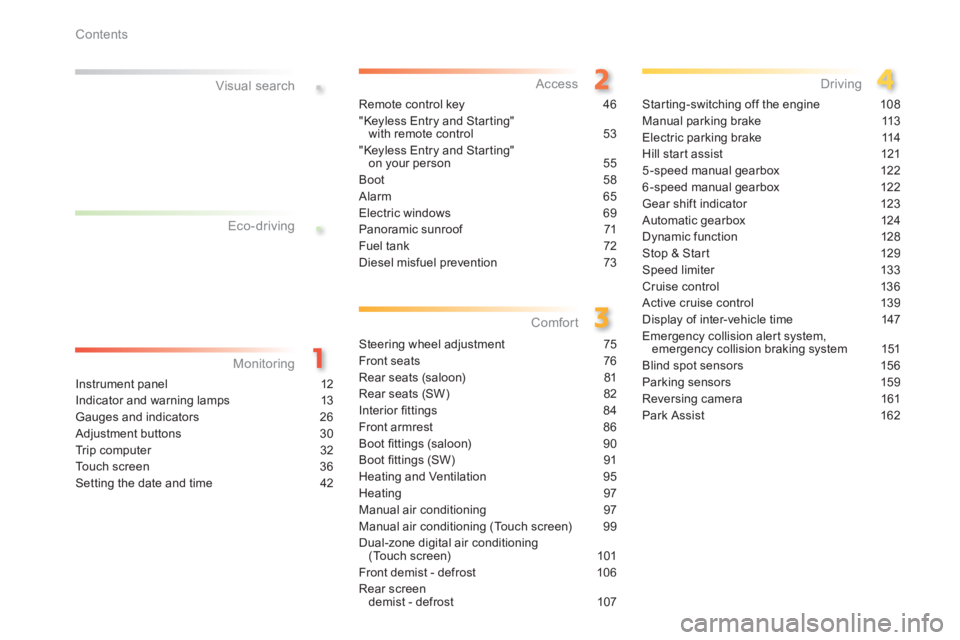
.
.
ContentsVisual search
Instrument panel 12
Indicator and warning lamps 13
Gauges and indicators 26
Adjustment buttons 30
Trip computer 32
Touch screen 36
Setting the date and time 42
Remote control key 46
"Keyless Entry and Starting" with remote control 53
"Keyless Entry and Starting" on your person 55
Boot 58
Alarm 65
Electric windows 69
Panoramic sunroof 71
Fuel tank 72
Diesel misfuel prevention 73
Steering wheel adjustment 75
Front seats 76
Rear seats (saloon) 81
Rear seats (SW) 82
Interior fi ttings 84
Front armrest 86
Boot fi ttings (saloon) 90
Boot fi ttings (SW) 91
Heating and Ventilation 95
Heating 97
Manual air conditioning 97
Manual air conditioning (Touch screen) 99
Dual-zone digital air conditioning (Touch screen) 101
Front demist - defrost 106
Rear screen demist - defrost 107
Starting-switching off the engine 108
Manual parking brake 113
Electric parking brake 114
Hill start assist 121
5-speed manual gearbox 122
6-speed manual gearbox 122
Gear shift indicator 123
Automatic gearbox 124
Dynamic function 128
Stop & Start 129
Speed limiter 133
Cruise control 136
Active cruise control 139
Display of inter-vehicle time 147
Emergency collision alert system, emergency collision braking system 151
Blind spot sensors 156
Parking sensors 159
Reversing camera 161
Park Assist 162
Eco-driving
Monitoring Access
Comfort Driving
Page 10 of 400
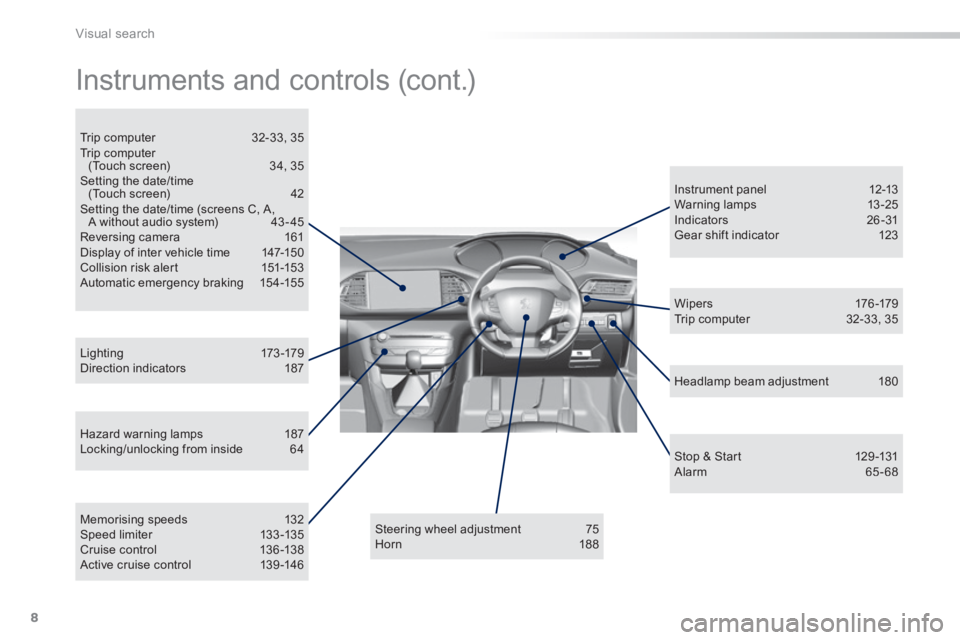
8
Visual search
Instruments and controls (cont.)
Hazard warning lamps 187 Locking/unlocking from inside 64
L i g ht i n g 173 -179 Direction indicators 187
Instrument panel 12-13 Warning lamps 13-25 Indicators 26 -31 Gear shift indicator 123
Steering wheel adjustment 75 Horn 188
Headlamp beam adjustment 180
Memorising speeds 132 Speed limiter 133 -135 Cruise control 136 -138 Active cruise control 139 -146
W i p e r s 176 -179 Trip computer 32-33, 35
Trip computer 32-33, 35 Trip computer (Touch screen) 34, 35 Setting the date/time (Touch screen) 42 Setting the date/time (screens C, A, A without audio system) 43 - 45 Reversing camera 161 Display of inter vehicle time 147-150 Collision risk alert 151-153 Automatic emergency braking 154-155
Stop & Start 129 -131 Alarm 65 - 68
Page 12 of 400
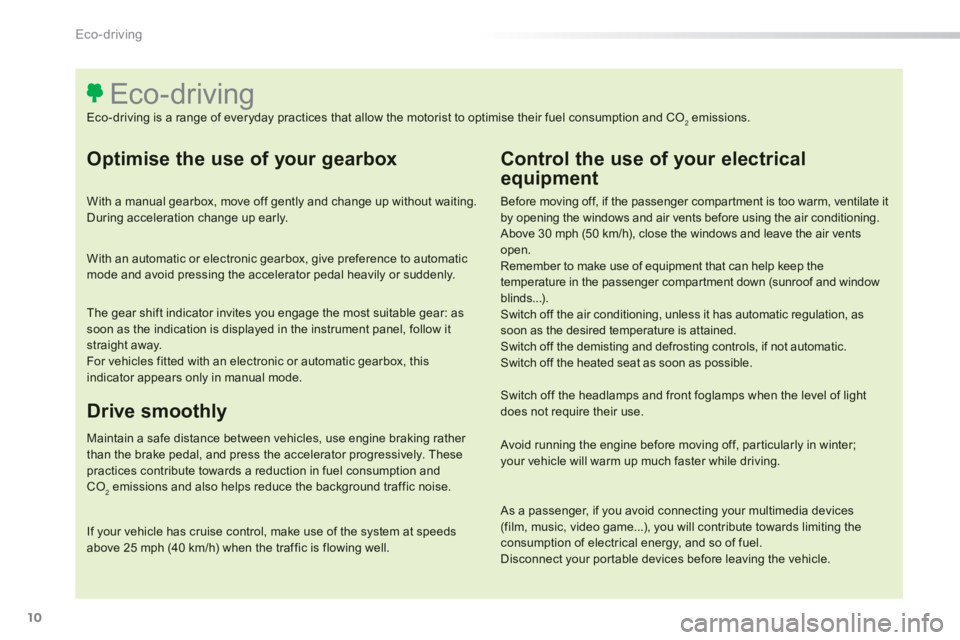
10
Eco-driving
Optimise the use of your gearbox
With a manual gearbox, move off gently and change up without waiting. During acceleration change up early.
With an automatic or electronic gearbox, give preference to automatic mode and avoid pressing the accelerator pedal heavily or suddenly.
Control the use of your electrical
equipment
Before moving off, if the passenger compartment is too warm, ventilate it by opening the windows and air vents before using the air conditioning. Above 30 mph (50 km/h), close the windows and leave the air vents open. Remember to make use of equipment that can help keep the temperature in the passenger compartment down (sunroof and window blinds...). Switch off the air conditioning, unless it has automatic regulation, as soon as the desired temperature is attained. Switch off the demisting and defrosting controls, if not automatic. Switch off the heated seat as soon as possible.
Switch off the headlamps and front foglamps when the level of light does not require their use.
Avoid running the engine before moving off, particularly in winter; your vehicle will warm up much faster while driving.
As a passenger, if you avoid connecting your multimedia devices (film, music, video game...), you will contribute towards limiting the consumption of electrical energy, and so of fuel. Disconnect your portable devices before leaving the vehicle.
Eco-driving
Eco-driving is a range of everyday practices that allow the motorist to optimise their fuel consumption and CO2 emissions.
Drive smoothly
Maintain a safe distance between vehicles, use engine braking rather than the brake pedal, and press the accelerator progressively. These practices contribute towards a reduction in fuel consumption and CO2 emissions and also helps reduce the background traffic noise.
If your vehicle has cruise control, make use of the system at speeds above 25 mph (40 km/h) when the traffic is flowing well.
The gear shift indicator invites you engage the most suitable gear: as soon as the indication is displayed in the instrument panel, follow it straight away. For vehicles fitted with an electronic or automatic gearbox, this indicator appears only in manual mode.
Page 14 of 400
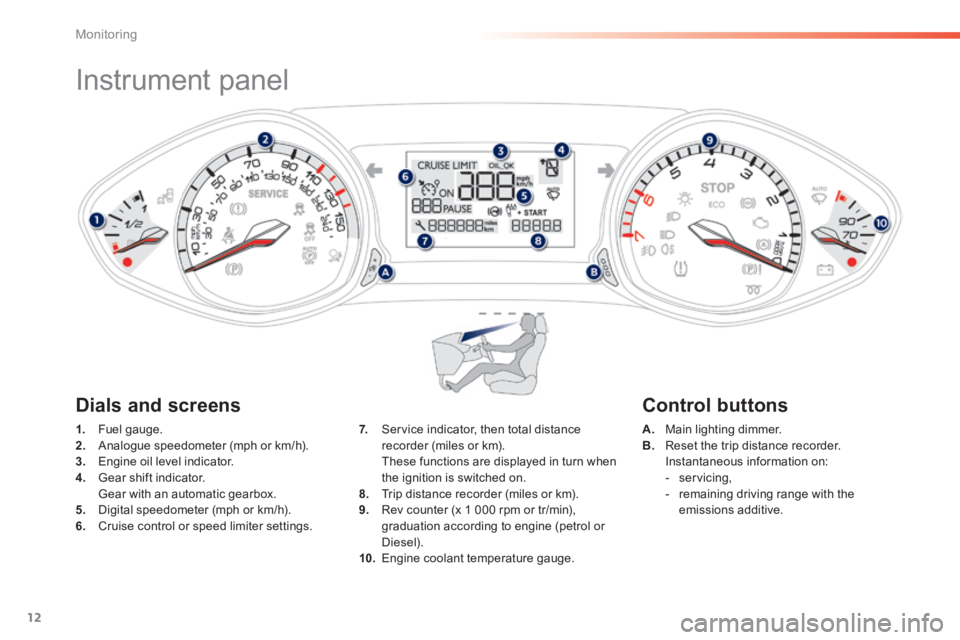
12
Monitoring
Instrument panel
1. Fuel gauge. 2. Analogue speedometer (mph or km/h). 3. Engine oil level indicator. 4. Gear shift indicator. Gear with an automatic gearbox. 5. Digital speedometer (mph or km/h). 6. Cruise control or speed limiter settings.
A. Main lighting dimmer. B. Reset the trip distance recorder. Instantaneous information on: - servicing, - remaining driving range with the emissions additive.
7. Service indicator, then total distance recorder (miles or km). These functions are displayed in turn when the ignition is switched on. 8. Trip distance recorder (miles or km). 9. Rev counter (x 1 000 rpm or tr/min), graduation according to engine (petrol or
Diesel). 10. Engine coolant temperature gauge.
Dials and screens Control buttons
Page 15 of 400
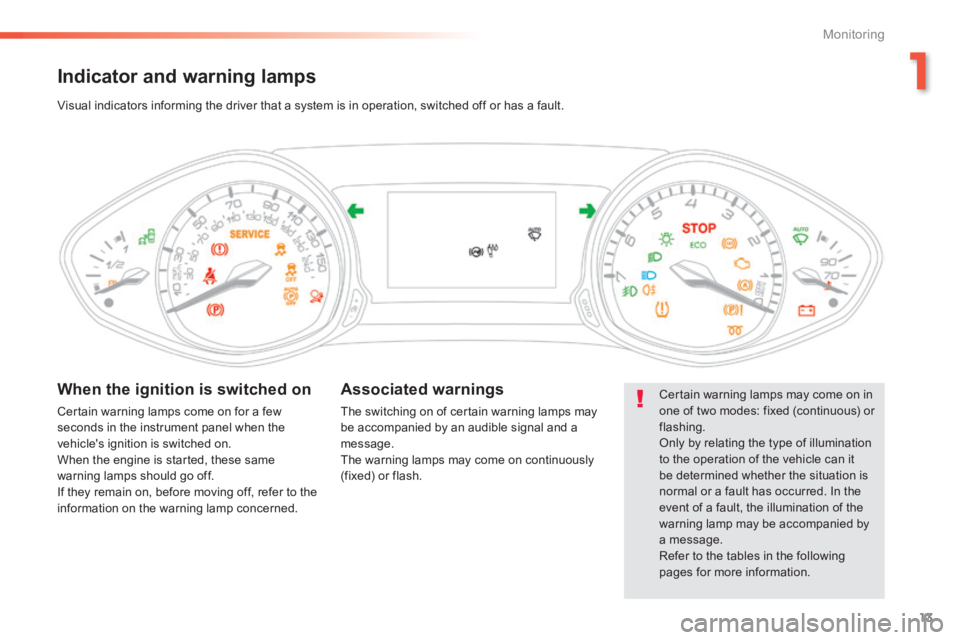
13
1
Monitoring
Indicator and warning lamps
Certain warning lamps may come on in one of two modes: fixed (continuous) or flashing. Only by relating the type of illumination to the operation of the vehicle can it be determined whether the situation is normal or a fault has occurred. In the event of a fault, the illumination of the warning lamp may be accompanied by a message. Refer to the tables in the following pages for more information.
Visual indicators informing the driver that a system is in operation, switched off or has a fault.
When the ignition is switched on
Certain warning lamps come on for a few seconds in the instrument panel when the vehicle's ignition is switched on. When the engine is started, these same warning lamps should go off. If they remain on, before moving off, refer to the information on the warning lamp concerned.
Associated warnings
The switching on of certain warning lamps may be accompanied by an audible signal and a message. The warning lamps may come on continuously (fixed) or flash.
Page 16 of 400
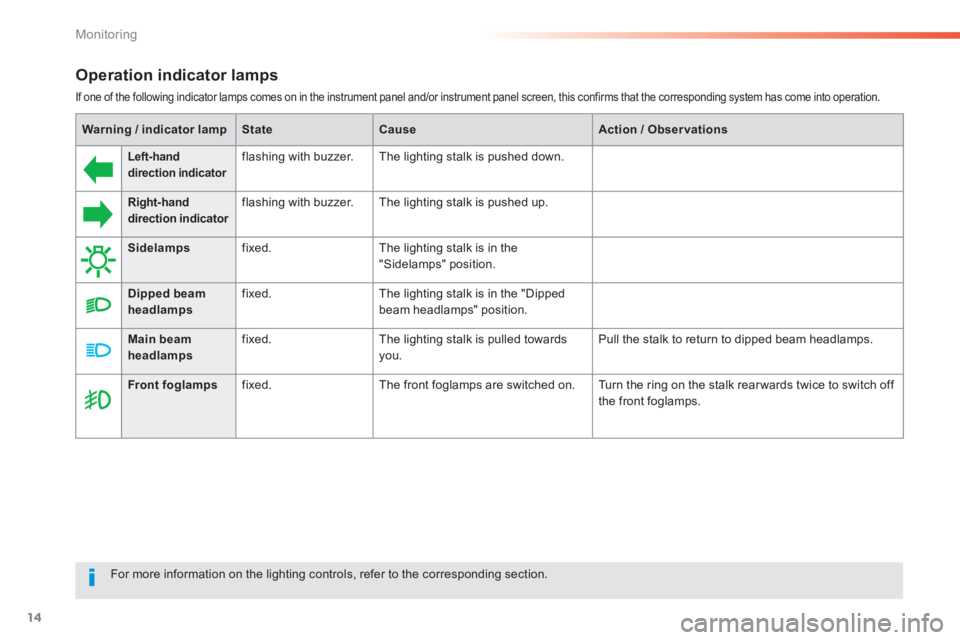
14
Monitoring
Operation indicator lamps
If one of the following indicator lamps comes on in the instrument panel and/or instrument panel screen, this confirms that the corresponding system has come into operation.
Warning / indicator lampStateCauseAction / Observations
Left-hand direction indicatorr r flashing with buzzer. The lighting stalk is pushed down.
Right-hand direction indicator flashing with buzzer. The lighting stalk is pushed up.
Sidelamps fixed. The lighting stalk is in the "Sidelamps" position.
Dipped beam headlamps fixed. The lighting stalk is in the "Dipped beam headlamps" position.
Main beam headlamps fixed. The lighting stalk is pulled towards you. Pull the stalk to return to dipped beam headlamps.
Front foglamps fixed. The front foglamps are switched on. Turn the ring on the stalk rear wards twice to switch off the front foglamps.
For more information on the lighting controls, refer to the corresponding section.
Page 27 of 400
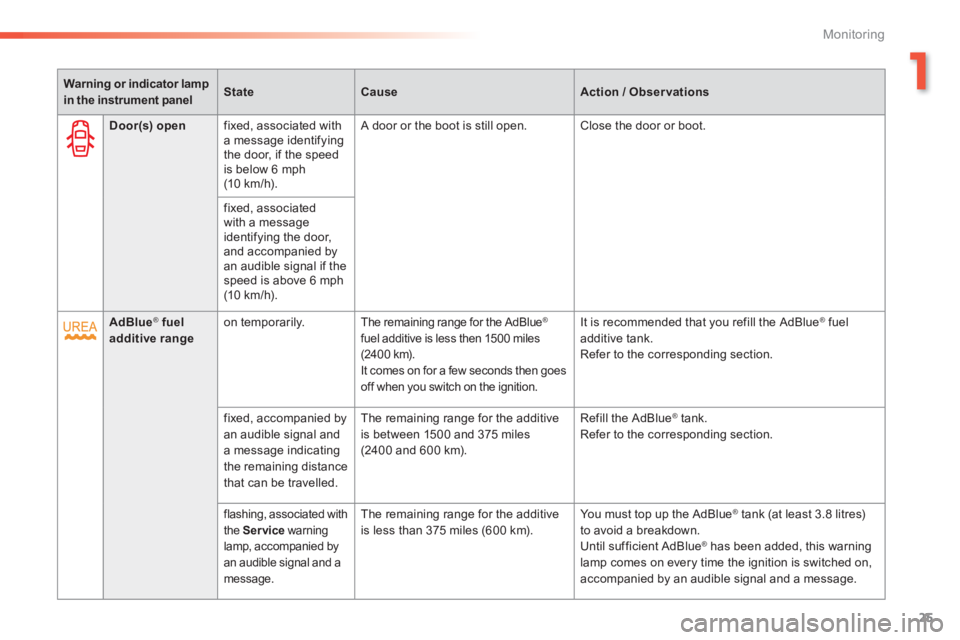
25
1
Monitoring
Warning or indicator lamp in the instrument panel StateCauseAction / Observations
Door(s) open fixed, associated with a message identifying the door, if the speed is below 6 mph (10 km/h).
A door or the boot is still open. Close the door or boot.
fixed, associated with a message identifying the door, and accompanied by an audible signal if the speed is above 6 mph (10 km/h).
AdBlue ® fuel ® fuel ®
additive range on temporarily. The remaining range for the AdBlue ® fuel additive is less then 1500 miles (24 0 0 k m). It comes on for a few seconds then goes off when you switch on the ignition.
It is recommended that you refill the AdBlue ® fuel ® fuel ®
additive tank. Refer to the corresponding section.
fixed, accompanied by an audible signal and a message indicating the remaining distance that can be travelled.
The remaining range for the additive is between 1500 and 375 miles (2400 and 600 km).
Refill the AdBlue ® tank. ® tank. ®
Refer to the corresponding section.
flashing, associated with the Service warning lamp, accompanied by an audible signal and a message.
The remaining range for the additive is less than 375 miles (600 km). You must top up the AdBlue ® tank (at least 3.8 litres) ® tank (at least 3.8 litres) ®
to avoid a breakdown. Until sufficient AdBlue ® has been added, this warning ® has been added, this warning ®
lamp comes on every time the ignition is switched on, accompanied by an audible signal and a message.
Page 31 of 400
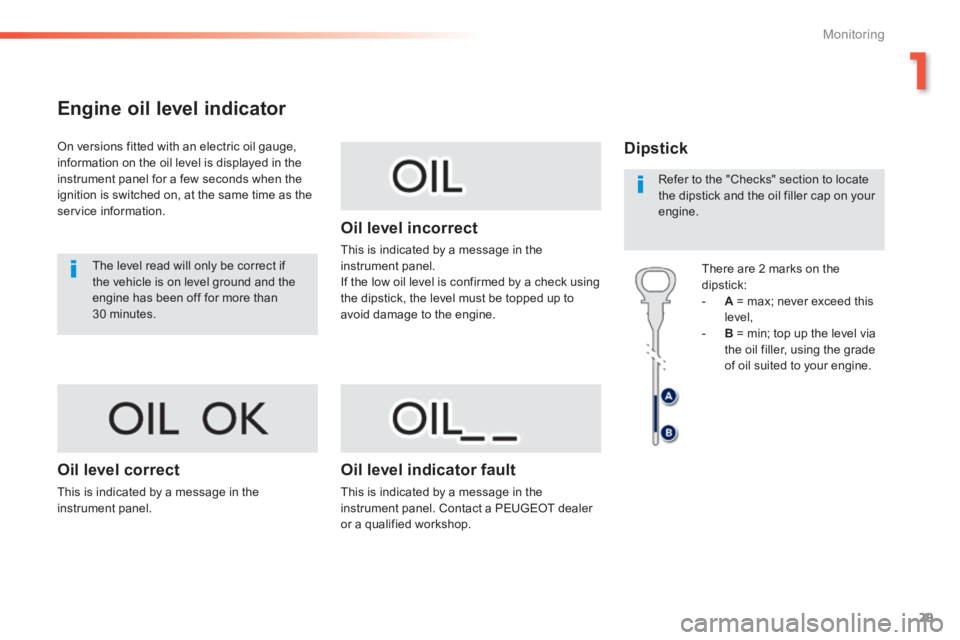
29
1
Monitoring
Engine oil level indicator
On versions fitted with an electric oil gauge, information on the oil level is displayed in the instrument panel for a few seconds when the ignition is switched on, at the same time as the service information.
The level read will only be correct if the vehicle is on level ground and the engine has been off for more than 30 minutes.
Oil level correct
This is indicated by a message in the instrument panel.
Oil level incorrect
This is indicated by a message in the instrument panel. If the low oil level is confirmed by a check using the dipstick, the level must be topped up to avoid damage to the engine.
Oil level indicator fault
This is indicated by a message in the instrument panel. Contact a PEUGEOT dealer or a qualified workshop.
Dipstick
There are 2 marks on the dipstick: - A = max; never exceed this level, - B = min; top up the level via the oil filler, using the grade of oil suited to your engine.
Refer to the "Checks" section to locate the dipstick and the oil filler cap on your engine.